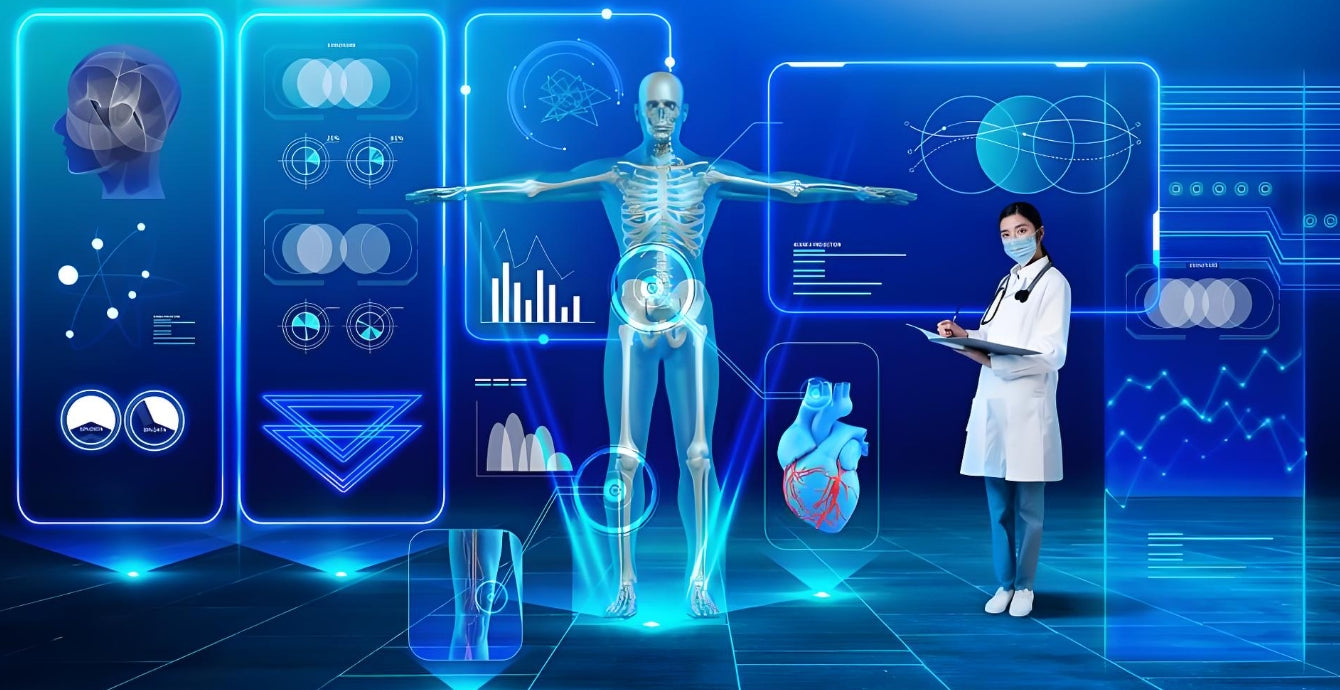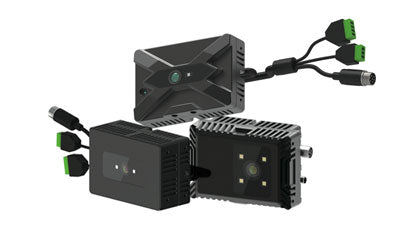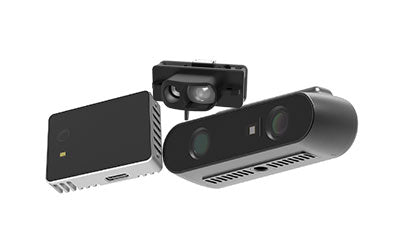TOF Tech Boosts Wearable Health Monitoring Precision & Intelligence

As smartwatches, smart glasses, and other wearable devices rapidly become popular, users demand higher functionality in health monitoring. Driven by low-power 3D sensing technology, the depth perception capability based on Time of Flight (TOF) sensors has become key to enhancing health monitoring accuracy in wearables.
What is a ToF time of flight sensor?
A ToF (Time of Flight) sensor calculates distance by measuring the time it takes for a light signal to travel from the emitter, reflect off an object, and return to the sensor. It quickly acquires high-precision 3D depth information and is widely used in robot navigation, gesture recognition, smart homes, and industrial automation. Simply put, a ToF sensor measures object distance by 'timing the flight of light.'
TOF Technology Principles and Advantages: Empowering Wearable Health Monitoring
Time-of-Flight (TOF) technology precisely calculates the distance between the sensor and an object by measuring the time infrared light takes to travel from the sensor, reflect off the human body, and return. This 3D imaging technology offers high precision, low latency, and strong resistance to ambient light interference, making it ideal for deployment in wearables with strict power and space constraints.
Compared to traditional 2D image recognition or accelerometer-based methods, TOF sensors can build real-time 3D depth maps of the human body, enabling advanced health sensing functions such as gesture recognition, gait analysis, fall detection, and respiratory rate monitoring. For example, in sleep monitoring, TOF sensors non-invasively track chest movements to calculate breathing rate and micro-movements. In motion tracking, TOF captures limb trajectories and quantifies angle changes to assist in scientific exercise.
With ongoing evolution of miniaturized TOF modules, such as the 3D ToF Camera M series and digital TOF (DTOF) solutions, these modules are entering the consumer market. They feature smaller size, lower power consumption, and better compatibility with mainstream SoC platforms, providing a robust hardware foundation for next-generation AI-driven health wearable devices.
TOF Technology Enables Precise Motion and Posture Capture
In health monitoring, TOF sensors are gradually transforming traditional health data collection with their high-precision, non-contact 3D depth perception. Compared with 2D images or single-point infrared sensors, TOF technology can acquire complete human posture and 3D spatial structure in real time under complex lighting conditions, greatly improving motion recognition accuracy and reliability.
Fall Detection
TOF 3D depth cameras continuously monitor users’ relative position and posture changes in space. When abnormal speed, sudden posture changes, or unusual displacement patterns are detected, the system quickly determines a fall event and triggers alerts via smart wearables, home health devices, or remote medical platforms. Compared to traditional accelerometers or cameras, TOF offers higher spatial resolution and better false alarm suppression, especially suitable for elderly, solitary, and chronic patients.
Motion Posture Analysis
Using 3D depth point cloud data collected by TOF, the system precisely locates key body joints such as shoulders, elbows, and knees, recording their spatial angles and motion trajectories in real time. This function is valuable not only in sports fitness (for motion correction and training evaluation) but also in rehabilitation medicine, including stroke recovery and post-operative physical therapy. Combined with AI algorithms, TOF technology enables automated posture analysis and personalized exercise prescriptions, greatly enhancing rehabilitation efficiency and training scientific accuracy.
Sleep Monitoring
In nighttime environments, TOF sensors use active distance measurement without ambient light, monitoring breathing movements, turning frequency, and sleep posture changes to provide comprehensive and continuous sleep behavior data. This technology is especially suitable for those who cannot wear devices, such as infants, elderly people, or patients with sleep disorders. Compared to traditional pressure mats or infrared night vision, TOF solutions offer better privacy protection and higher data accuracy.
With continuous optimization, TOF technology’s application potential is increasingly evident in smart wearables, smart healthcare, and home health management. From basic health protection to complex motion assessment, TOF helps build a more intelligent, precise, and unobtrusive future health monitoring system. It also opens new growth opportunities for the 3D machine vision industry, advancing personalized health services toward deeper integration.
Trends and Challenges in Miniature TOF Modules
Driven by rapid advances in semiconductor manufacturing, packaging, and 3D sensing algorithms, miniature TOF 3D sensor modules are breaking through traditional limits in size and performance, moving toward smaller size, higher integration, lower power consumption, and stronger computing capability. This trend promotes intelligent upgrades in consumer electronics and wearables and unlocks new application spaces in medical health, IoT, and XR devices.
Miniaturization and High Integration
Representative miniature TOF modules, such as the 3D M series, integrate the emitter (VCSEL laser), receiver (SPAD or CCD/CMOS), optics, and depth processing engine on a compact PCB, effectively reducing module size and simplifying system wiring. While maintaining high-resolution imaging (e.g., QVGA or even VGA level), power consumption has been greatly lowered, supporting long-term wearable scenarios such as smart glasses, ear-worn hearing aids, and health wristbands.
Some manufacturers also fuse TOF modules with IMUs (inertial measurement units), ambient light sensors (ALS), and barometers, forming integrated multimodal sensing platforms. This high-level integration saves device space and enhances system data synergy.
Key Technical Challenges
Despite the broad commercial prospects brought by miniaturization, several engineering and algorithm challenges remain:
-
Multipath Interference (MPI): Since TOF ranging relies on light signal round-trip time, multiple reflections from object surfaces cause measurement errors. Miniature modules, constrained by size and power, cannot deploy complex optics or high-energy lasers, aggravating MPI issues.
-
Ambient Light Interference: Outdoor strong light or complex lighting environments interfere with TOF modules’ active light detection, affecting ranging stability. This is especially problematic for wearables and mobile devices requiring multi-scene adaptability.
-
Thermal Noise and Electromagnetic Interference (EMI): Smaller module size brings components closer, increasing interference coupling and reducing signal quality, which impacts imaging reliability.
-
Manufacturing and Packaging Complexity: Miniaturization demands highly precise packaging and testing processes such as wafer-level packaging (WLP) and system-in-package (SiP). These high technical thresholds increase costs and challenge yield control.
Future Development Directions and Solutions
To address the aforementioned challenges, the industry is making coordinated breakthroughs across multiple dimensions:
-
Algorithm Optimization: Employing time-domain filtering, multi-frequency modulation demodulation, deep learning-based denoising, and other techniques to reduce ranging errors caused by multipath interference (MPI) and ambient light.
-
Advanced Optical Design: Introducing diffractive optical elements (DOE), microlens arrays, and other structures to enhance light field control capability, improving anti-interference performance and field-of-view uniformity.
-
Low-Power Design: Utilizing dynamic frame rate adjustment, adaptive laser modulation, and regional wake-up scanning mechanisms to reduce power consumption while ensuring performance.
-
Heterogeneous Integration Platforms: Integrating TOF sensors with AI computing cores on system-on-chip (SoC) platforms to enable efficient edge computing combined with real-time sensing.
Overall, miniature TOF modules are becoming key hardware components for the new generation of intelligent devices to realize spatial perception, behavior recognition, and human-computer interaction functions. As technological bottlenecks are gradually overcome, future developments will feature stronger performance, wider viewing angles, and lower costs, becoming important growth drivers in the 3D vision industry and smart wearable market.
TOF Technology Principles and Advantages: Empowering Wearable Health Monitoring
Time-of-Flight (TOF) technology is an advanced active 3D sensing solution. By emitting infrared light pulses or modulated light waves and measuring the time taken for light to travel from emission to reflection and back, TOF precisely calculates the distance to object surfaces, thereby constructing a complete three-dimensional depth map. This technology not only achieves sub-centimeter ranging accuracy but also supports real-time imaging (with millisecond-level latency) and maintains excellent anti-interference capability under varying lighting conditions. Hence, it is highly suitable for wearable health monitoring devices with stringent requirements on size, power consumption, and data precision.
Differences Between TOF and Traditional Sensing Technologies
Compared to traditional 2D image recognition technologies (e.g., RGB-based detection) or solutions relying on inertial sensors like accelerometers and gyroscopes, TOF inherently provides spatial depth perception, independent of environmental background or lighting conditions, and does not require long-term data accumulation to infer motion trends. Instead, it instantly and directly acquires 3D posture and motion trajectory information, giving it irreplaceable advantages in scenarios such as:
-
Gesture Recognition and Contactless Interaction: Users can control devices or switch menus with simple finger or palm movements, enabling natural interaction experiences, especially suitable for smartwatches, AR glasses, and other compact devices.
-
Gait and Posture Analysis: By tracking 3D coordinates of key body joints in real-time, TOF can analyze walking posture, step frequency, stride length, etc., providing quantitative metrics for rehabilitation training or posture correction.
-
Fall Detection and Alert Systems: Using sudden changes in 3D posture data (e.g., rapid vertical height drops, abnormal posture transitions), TOF can accurately detect fall events with higher reliability and lower false alarm rates than traditional accelerometer-based methods.
-
Sleep and Breathing Monitoring: TOF sensors deployed bedside or in head-worn devices can detect chest rise and fall amplitude and frequency to monitor breathing rhythms, snoring, or even sleep apnea risks, offering completely contactless monitoring advantages.
-
Posture Tracking and Exercise Guidance: Providing real-time feedback on limb movement trajectories and joint angle changes, applicable to home fitness coaching, physiotherapy evaluation, and virtual trainer interactions.
Miniature TOF Modules Accelerate Consumer-Level Adoption
With continual miniaturization and cost optimization, a series of highly integrated TOF module products such as the 3D ToF Camera M series and DTOF (Digital Time-of-Flight) solutions are rapidly penetrating the consumer market. The new generation modules integrate laser emitters, receiver arrays, optical systems, and depth-processing SoCs at the hardware level, and support SDKs compatible with mainstream mobile platforms (e.g., Qualcomm, MediaTek, Huawei HiSilicon), making deployment in smartwatches, smart rings, AR/VR glasses, smart earphones, and health bands more convenient and low-threshold.
For example, some flagship wearable devices have adopted VGA-resolution DTOF modules with multi-region dynamic sensing (ROI sensing), scanning only critical areas at high frequency. This approach ensures data accuracy while achieving ultra-low power consumption, which is crucial for all-day wearable health monitoring devices, extending battery life while maintaining continuous and reliable measurements.
Future Trends: AI Algorithm Enhancement + TOF Hardware Upgrades
In the future, TOF technology will further integrate deeply with AI algorithms to enable more complex human behavior recognition and health state assessment. By running pose recognition models, action classifiers, and anomaly detectors locally at the edge, devices can process large volumes of 3D data in real-time, ensuring user privacy and improving responsiveness.
On the hardware front, TOF modules will evolve towards:
-
Higher Resolution and Wider Field of View: To accommodate complex dynamic scenes and multi-person tracking.
-
Ultra-Low Power Operation Modes: Supporting long-duration scenarios such as sleep monitoring.
-
Flexible Packaging and Irregular Integration: Suitable for a broader range of wearable form factors.
-
TOF + RGB + IMU Multimodal Fusion: Achieving higher precision and stronger robustness in health monitoring systems.
TOF is not only the core sensing technology for realizing high-dimensional, contactless health perception but also the key driver for advancing the next generation of smart wearables toward being 'more understanding, safer, and more convenient.' With continued miniaturization, intelligent algorithms, and enhanced platform compatibility, TOF will play an increasingly vital role in the global health technology industry.
Multimodal Sensing: The Future Direction of Wearable Devices
Future wearable devices will no longer rely on single sensing technologies alone but will integrate TOF 3D depth cameras with other sensors such as accelerometers, heart rate sensors, and RGB-D cameras, achieving multimodal sensing to comprehensively improve the accuracy and intelligence of health monitoring.
By combining 3D SLAM (Simultaneous Localization and Mapping) and AI algorithms, wearable devices will possess enhanced environmental awareness and user behavior understanding, ushering intelligent health management into a new era.
Summary:
Based on TOF 3D depth sensing technology, with its unique advantages, wearable health monitoring devices are entering a stage of higher precision and greater intelligence. As miniature TOF modules and semiconductor processes continue to advance, future wearable devices will offer more intimate and reliable health services in fall detection, motion analysis, sleep monitoring, and more, becoming core instruments of intelligent health management.
Synexens Industrial Outdoor 4m TOF Sensor Depth 3D Camera Rangefinder_CS40
Our professional technical team specializing in 3D camera ranging is ready to assist you at any time. Whether you encounter any issues with your TOF camera after purchase or need clarification on TOF technology, feel free to contact us anytime. We are committed to providing high-quality technical after-sales service and user experience, ensuring your peace of mind in both shopping and using our products






